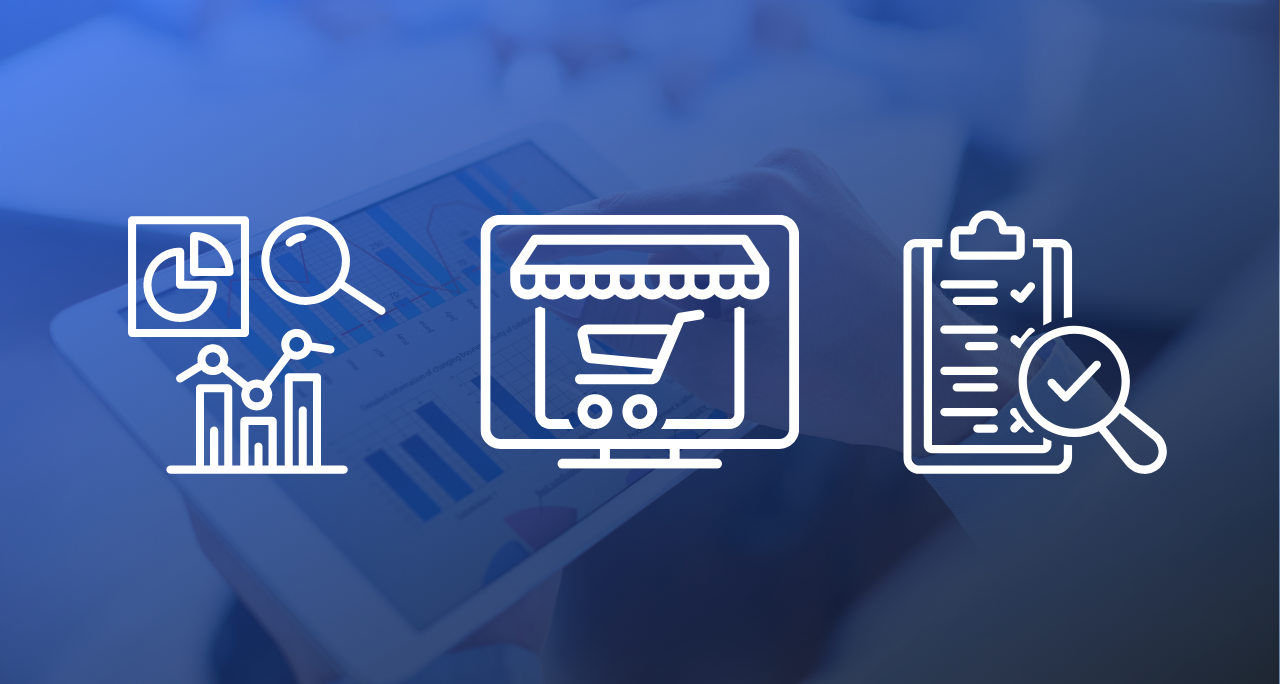Reliable, real-time insights on customer behavior are a great way to help you tailor user experience, and increase customer acquisition and conversion rates. But how do you get your hands on those insights? A solid eCommerce analytics tool is the answer.
Not every tool is a good fit for every business, though. So, before you jump into purchasing one, take a look at our list of 11 considerations for evaluating eCommerce analytics solutions.
What are eCommerce Analytics Tools?
eCommerce analytics tools are platforms that gather data across your website, marketing channels, online store, social media, and any other channels used for eCommerce activity. Then, they contextualize this data to help you understand trends and shifts in consumer behavior.
With these tools, you can make business decisions based on data — not intuition or guesswork.
Here are a few examples of the most popular eCommerce analytics tools out there:
Google Analytics. One of the most well-known web analytics tools around, Google Analytics provides hundreds of detailed reports, integrations, and tutorials to bring your entire team up to speed with how users interact with a website.
- This comprehensive platform for eCommerce and SaaS businesses provides detailed information about customer behavior to help you increase customer acquisition and retention.
Adobe Marketing Cloud. Large eCommerce stores often flock toward Adobe Marketing Cloud due the power of its analytics. However, it does require a level of knowledge to set up and use properly, and needs a significant financial investment.
- By integrating eCommerce analytics with a CRM and email marketing systems, this platform shortens the time between analysis and action. The platform also integrates with WooCommerce, Magento, and Shopify.
- This platform contains some excellent freemium options that display heat maps showing which categories, pages, and products are getting the most activity.

11 Things to Look at When Evaluating eCommerce Analytics Solutions
With the many options of tools available, it’s important to think carefully about your business needs when choosing eCommerce analytics tools. Here’s what to keep in mind:
1. Alignment With Your Goals
The first thing you should do is set out your goals clearly and precisely. Are you laser-focused on driving conversion rates? Are you trying to reduce abandoned shopping carts? Do you want to understand shopping behavior?
Identifying your priorities – which are linked to your company’s maturity stage and the type of product/service you’re selling — will help you choose a product that is best suited to achieving your goals. It’s all about relevance. No business wants to spend money on something that doesn’t move the needle.
2. Breadth of Solutions
Once you map out your main goals, you can start to better understand which types of solutions you need to reach them. When you’re first starting out, a simpler tool may seem appealing. But, if it can’t analyze complex data and turn it into actionable insights, tables, and graphs, then it’s unlikely you’ll get much use out of it.
Conversely, there’s no point committing to something that offers a huge range of features that you’re simply not going to use. Always keep in mind the scope you require.

3. Automation Capabilities
Collecting and analyzing data shouldn’t be a hassle. That’s why automation capabilities are such an important consideration. Powerful automation can reduce redundancy, remove disconnectivity, and increase your overall growth and efficiency.
That way, you can focus on the most important thing: generating revenue. Make sure that your platform can create workflows and rules that can run in the background so your team isn’t having to handle manual data entry and collection tasks, or become overwhelmed with reports.
An example is how your tool will be able to handle web testing. Many eCommerce analytics tools enable you to run multi-page and multivariate experiments in the background, and may even show you prescriptive insight based on results.
Tools like Optimizely also use AI and big data to constantly analyze content and real-time behavior of shoppers (e.g. shopping cart abandonment) and automatically trigger retargeting campaigns when needed.
4. Omnichannel Approach
In the modern world, no eCommerce business can rely on just one channel to grow. Instead, the best companies find ways to unify data across channels while maintaining its integrity and quality — in other words, using an omnichannel strategy. So, any eCommerce analytics tool you choose should help you do just that.
So, find a platform that incorporates all customer behavior data, from website visits, emails, and social media engagements to marketing campaigns, purchases, and every other step across the entire customer journey. That way, you can break out of data silos and ensure business decisions are based on an understanding of the overall picture rather than a narrow snapshot.

5. User Experience
Everyone talks about the importance of user experience in eCommerce. And that’s understandable. After all, if customers have difficulty navigating your site, they’re less likely to make a purchase.
Those same UX considerations apply to any eCommerce analytics tool you use yourself. It needs to be intuitive enough that your team — including non-technical members — can actually use it to get the insight they need. An intuitive solution will include easy-to-access dashboards and clean views of data, as well as practical features like alerts and mobile compatibility. An effective system to manage user permissions is also important to make sure your team has access to relevant data.
If your people can’t use the platform with ease, then they won’t be able to make heads or tails of the data, meaning you won’t have actionable insights to improve your business.
6. Scalability
When you invest in an analytics platform, think not only about what you need now, but what you’ll need in the future, too. While it’s impossible to predict exactly where your business will be in a few years, it still pays to make sure that your platform is scalable and can grow alongside your business. This way, you won’t have to keep repeating the selection process down the line.
For example, even if you plan to choose a less expensive pricing package at the beginning, it pays to check the more advanced ones, too. A growing business will quickly need something more than the freemium version that some tools offer (e.g. Smartlook’s freemium plan is useful for startups but not for established businesses). Ask about other features that can be added on top of your existing plan should you need them.
Another element to consider is how you’ll be able to manage changing data needs in the future. Evaluate data storage capabilities to make sure you can keep using the tool without losing historical data. Make a point to ask about data migration policies, too, in case you need to move to a new platform or website later.

7. Custom and Ad Hoc Reporting
While the best eCommerce analytics tools will come with built-in reports, there are also specific use cases and business insights that you and your leadership will need. As a result, it’s important to look for a platform that has significant customization and reporting capabilities for specific metrics.
The best way to make this happen is to select a tool that doesn’t require heavy IT knowledge to operate. If you have to rely on your IT team to build each new report, that will bog down the process. Instead, choose a user friendly platform that allows anyone to build reports easily, often through templates. Or, make a point to ask how the platform’s team can set up customer reports and how long it may take.
8. Relevant Use Cases
A great question to ask during the sales process is whether companies similar to yours use the platform.
Diving into those examples can help to illuminate aspects of the platform that serve your specific use cases, and demonstrate whether (and how) you can use it to accomplish your goals. It may even introduce you to a few new ways you can use analytics to benefit your business that you wouldn’t otherwise have thought of.

9. Security and Performance
Because your eCommerce platform will contain immense amounts of data that are critical to your business, understanding the security measures in place to protect that data is incredibly important. The last thing you want is a data breach — customers may lose trust in your business.
As a minimum, you should verify that all necessary measures are in place to protect user privacy and comply with relevant regulations like GDPR, CCPA, and other applicable statutes.
10. Integrations
Your eCommerce analytics tool won’t exist in a vacuum. Instead, it’s going to be part of a much larger tech stack. As a result, you should make sure that it integrates directly with all of your existing technologies.
It’s a good idea to keep your plans for the future in mind and preempt the need to integrate further technologies later on. That way you’ll avoid investing in a data analytics platform that leaves you constantly looking for workarounds to patch in other technologies.

11. Pricing
Finally, make sure that the tool you’re looking at fits within your budget. Just as importantly, make sure that you’ll be able to demonstrate an ROI down the line.
While it may be difficult to do this when you’re just starting out (after all, you need the analytics platform to collect the data necessary to calculate these figures), having some idea of how you expect the numbers to pan out can help build confidence that the pricing works for you.
eCommerce Analytics Tools are Super Insightful
Once you select the proper eCommerce analytics tool, you’ll be able to take the guesswork out of important business decisions. Use the valuable data collected from these tools to inform your team what to focus on or improve.
If you’re running an online store, understanding how customers interact with your products and website is a high priority. That’s why eCommerce analytics tools provide the right type of insights to grow your business and increase sales.
About Author

Timothy Wier is a freelance content writer at Acquire, with an avid interest in the role of data and automation in providing personalized, contextual customer experiences.





